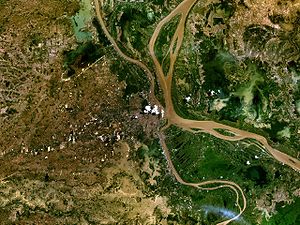
The Phnom Penh Water Supply Authority (PPWSA) (Khmer: រដ្ឋាករទឹកស្វយ័តក្រុងភ្នំពេញ) is the municipal water utility that serves Cambodia's capital Phnom Penh and surrounding areas.
In 1992 it provided low-quality piped water at very low pressure (0.2 bar) for only 10 hours per day to only 20% of the city's residents. Non-revenue water was extremely high at 72% due to illegal connections, manipulation of bills and physical leakage. Tariffs were extremely low, there was no metering and less than half of the amounts billed were collected. Staff were underpaid and demoralized. The utility then underwent a dramatic turnaround—staff engaged in corrupt activities were fired, bill payment was enforced, illegal connections were regularized, metering was introduced and the utility gained autonomy from the municipality in financial and personnel matters.[1]
In the next fourteen years the customer base multiplied by nine reaching over 90% of residents, service quality improved from intermittent to continuous supply of safe drinking water at good pressure of 2 bar, and non-revenue water was cut to only 6%. Tariffs were increased and the utility went from being bankrupt to making a modest profit. It now has motivated, well-paid staff. According to one observer, in 2012 its "public image is excellent".[1]
The key to its success laid in "leadership, professionalism, integrity (and) commitment" as well as "community participation and information sharing (...), good governance, transparency and accountability".[1] Significant financial support from external donors, initially through grants and then through soft loans, also was essential in making the turnaround possible. PPWSA's achievements were recognized through international awards, including the Ramon Magsaysay Award for Government Service in 2006 and the Stockholm Industry Water Award in 2010.
